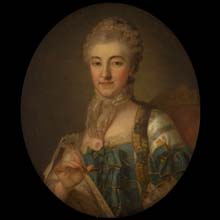
material: oil on canvas
dimensions: 65 x 55 cm
description: Izabela Branicka, née Potocka, (1730–1808) had close contact with her younger brother, Stanisław Antoni, the future king of Poland, already in her childhood. At the age of 18, she married Jan Klemens Branicki, who was three times older than her. The marriage was arranged by the Czartoryski’s Familia (political party) and the Poniatowski family in hopes that it would help them involve one of the most powerful Polish magnates in their plans for reforming the country. Unfortunately, Branicki pursued his own policy which gradually led to the collapse of the country. His wife supported him regardless of circumstances, even when he acted against her family’s interest. Izabela Branicka was a close adviser to the king throughout all her life. She was involved in the political life of the country by supporting the Kościuszko Uprising and helped in the operation of the Commission of National Education by developing education. After Branicki’s death in 1771, Izabela married the love of her life, General Andrzej Mokronowski. She realized her dream with him – visiting France. The portrait of Izabela Branicka, painted by Per Krafft, a Swedish painter staying in Poland between 1767 and 1768, was commissioned by Stanisław August. This work and the portraits of other members of the royal family decorated the Dining Room in the Łazienki Palace in Warsaw, where intellectuals, artists and writers met at the famous Thursday Dinners. Barbara Ciciora
exposition: The Gallery of 19th Century Polish Art in Sukiennice,
The Cloth Hall, 1, Main Market Square
key: Enlightenment >>>
dimensions: 65 x 55 cm
description: Izabela Branicka, née Potocka, (1730–1808) had close contact with her younger brother, Stanisław Antoni, the future king of Poland, already in her childhood. At the age of 18, she married Jan Klemens Branicki, who was three times older than her. The marriage was arranged by the Czartoryski’s Familia (political party) and the Poniatowski family in hopes that it would help them involve one of the most powerful Polish magnates in their plans for reforming the country. Unfortunately, Branicki pursued his own policy which gradually led to the collapse of the country. His wife supported him regardless of circumstances, even when he acted against her family’s interest. Izabela Branicka was a close adviser to the king throughout all her life. She was involved in the political life of the country by supporting the Kościuszko Uprising and helped in the operation of the Commission of National Education by developing education. After Branicki’s death in 1771, Izabela married the love of her life, General Andrzej Mokronowski. She realized her dream with him – visiting France. The portrait of Izabela Branicka, painted by Per Krafft, a Swedish painter staying in Poland between 1767 and 1768, was commissioned by Stanisław August. This work and the portraits of other members of the royal family decorated the Dining Room in the Łazienki Palace in Warsaw, where intellectuals, artists and writers met at the famous Thursday Dinners. Barbara Ciciora
exposition: The Gallery of 19th Century Polish Art in Sukiennice,
The Cloth Hall, 1, Main Market Square
key: Enlightenment >>>












